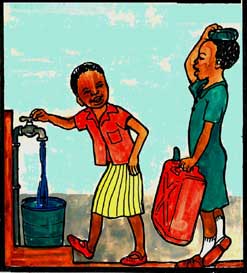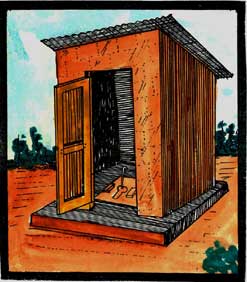 |
||||
|
|
||||
What is the purpose? |
||||
|
|
||||
| What is the purpose of this Toolkit?
Aim: The aim of the toolkit is to provide sector practitioners, policy and decision-makers access to information on current trends and knowledge gained from past experience regarding water supply and sanitation service delivery to low income urban areas. The toolkit should enable readers to identify problems or challenges, and draw up a strategy for addressing these challenges using information and other resources assembled for this purpose. Issues and principles: The toolkit provides the reader with a set of issues and principles that guide service delivery to low income communities. It offers practical advise on getting to know low income customers better, presents pros and cons of a range of options for service delivery, suggests how various institutions may support improvements in service delivery, identifies key policy, legal and regulatory features; looks into financing issues and mechanisms, and provides the reader with a wide range of resources to work with. Basis of information: The toolkit is based on information gathered over several years from a series of consultative workshops at country and regional level, case studies compiled in more than 13 African countries, existing resources and knowledge of sector practitioners and through research carried out by various institutions. It is intended that the toolkit be developed and updated over time building on experience and knowledge generated through various activities at country, regional and international level. Toolkit: This toolkit has been developed through the Water Utility Partnership (WUP) Project No. 5 – Improving Utilities Capacity to Deliver Water Supply and Sanitation Services to Low Income Urban Communities; and Project No. 4 – Hygiene Education and Environmental Health. Funding has been provided by the European Commission. The project is managed by the Water and Sanitation Program on behalf of the (WUP), supported by the World Bank’s Africa Infrastructure Unit.
|
||||
|
||||
|
What are the challenges in providing services for the urban poor? 1. Rapid Urbanization The world is steadily becoming more urban, as people move to cities and towns. They search for employment and educational opportunities and higher standards of living, migrating from rural lands that can no longer support them. Today, almost half of humanity lives in urban areas, and the urban population is growing two and a half times faster than its rural counterpart. By the year 2025 urban areas are expected to be home to more than two-thirds of the world's people. Already the world is largely urban, and even in rural areas life is increasingly affected by the changes created by the growth of cities. Many cities and towns in the developing world are already characterized by high levels of air and water pollution, slums, deteriorating infrastructure, and poor waste management systems. The resulting exposure to microbiological pathogens due to unsafe drinking water, inadequate sanitation, and poor waste management is one of the most serious environmental health threats in developing countries. Rapid rates of urban population growth strain the capacity of national and local governments to provide basic services. Often the resulting inability to keep pace causes human suffering, environmental damage and unsustainable patterns of development. See also: The Challenges of Urbanization in Africa 2. Growing Poverty One major area of concern about the growth of urban populations is the already high incidence of urban poverty. Today there are at least 600 million people in urban areas who cannot adequately provide for their basic needs in shelter, employment, water and health. It is estimated that approximately one half of the populations of several of the cities in some of the world's poorest countries already are living below official poverty levels. While the proportion of the poor has decreased in a number of the world's regions, as the population has increased in size, the absolute number of the urban poor is increasing. At the same time, in Asia, the incidence of urban poverty has been decreasing since the mid-1980s in a number of countries, which clearly indicates that something can be done. 3. Informal settlements As a result of declining economic performance and urbanization, many urban centers are expanding at a fast pace, and are increasingly characterized by rising poverty levels and a growing informal sector. A disproportionate number of urban residents are now housed in informal settlements that are not planned, often unserved and sometimes illegal. To meet future requirements, utilities will need to develop the skills and knowledge to adequately respond to demand of low income households, who will comprise the majority of potential new customers. 4. Deteriorating public and environmental health Poor urban communities suffer an alarming lack of access to basic water, sewage, and rubbish disposal services, which makes it almost impossible for them to reduce contamination of water and food, maintain adequate levels of hygiene, or control insect-vectors of disease. 5. Declining utility performance See also: Low income as customers 6. Decentralization Decentralization implies that the responsibility of managing cities and towns lies primarily with local authorities. However, in many developing countries, the move towards decentralization has not led to a corresponding increase in local authorities’ revenue base, rendering local authorities powerless when it comes to implementation. This is partly due to the fact that national governments are unable to channel or reallocate finance to local authorities as their budgets are already strained. Inefficiencies in the legal and administrative machinery and corruption have further eroded the financial capacity of local authorities. As a result, urban service provision is deteriorating, if not completely absent, in many cities and towns, especially in developing countries. 7. Private sector participation The private sector improves efficiency and lowers costs by introducing commercial principles such as limited and well-focused performance objectives, financial and managerial autonomy, a hard budget constraint, and clear accountability to both customers and providers of capital. Private participation in water and wastewater utilities has generally resulted in sharp efficiency gains, improved service and faster investment in expanding coverage. However, designing and implementing sustainable solutions to respond to the needs of the urban poor remains a challenge. The poor may be unable to afford the cost of household connections. They may be located far from main water distribution lines, live on untenured land, or in neighborhoods where terrain or the absence of public rights of way prevent the construction of traditional piped water or sewerage networks. Traditional utility billing systems may not be compatible with the way poor households handle their budgets, and not all may be aware of the benefits and use of safe water and sanitation services. See also: Private Sector Participation
|
||||
|
How do you navigate through the Toolkit? Several options are available to the practitioner for accessing information: Home page provides the initial entry to all information. Clicking on the headings brings the practitioner directly to the topic area. Clicking on 'Sponsors' brings you directly to their web sites. Tabs at the top of each page direct the practitioner to key topic areas. Subheads are included and may be clicked to go directly to that subsection. ‘Quick Guide’ box at the end of main sections highlights Definitions, Abbreviations, Case Examples and More Information, appropriate to that section. Click on topic to access.
|
||||
|
How can the practitioner use the Toolkit? How does the practitioner select the right strategy? What should a strategy consist of? Following is a checklist of key issues that comprise a good strategy.
What process should the practitioner use to develop a strategy? Following is a checklist of key steps that should be considered. This outline may be used at both the national and the utility agency level.
|
||||
|
|
||||
|
The web site and CD was prepared for the Water Utility Partnership, as part of Phase III of Project 5: ‘Strengthening the Capacity of Water Utilities to deliver Water and Sanitation Services, Environmental Hygiene Education to Low Income Urban Communities’. The Project Manager was Ms. Mukami Kariuki, who also worked as Subregional Coordinator East and Southern Africa. Funding support came from the European Commission and the Water and Sanitation Program (WSP). The Toolkit was prepared by SIGUS – Special Interest Group in Urban Settlement-MIT, directed by Reinhard Goethert. Web site and CD design was by Will Donovan. The initial layout and text was substantially contributed by Ms. Mukami Kariuki and Dr. Paul Taylor, assisted by Ms. Esther Muya and Ms. Helina Tirfie. Completion of the material and additional research support was provided by Dr. Jennifer Davis and Danny Cherian, Graduate Assistant, Department of Urban Studies and Planning, MIT. Dennis Mwanza from the Water Utility Partnership and Jean Doyen from the Water and Sanitation Program coordinated the peer review of the Toolkit. The sketches used throughout are from an unknown local artist - many thanks. The views and interpretations herein should not be attributed to the Water Utility Partnership Copyright © 2001-2003. The Water Utility Partnership. All Rights Reserved. |
||||
|
||||


